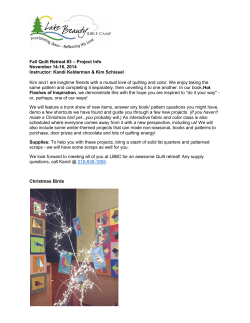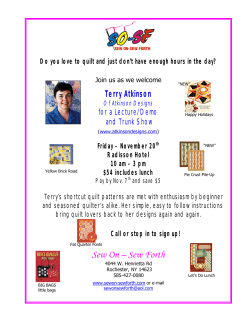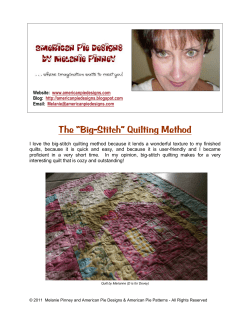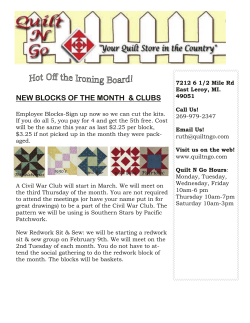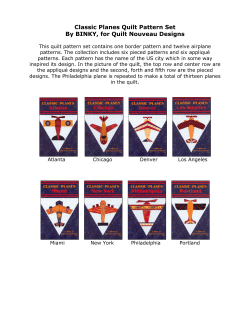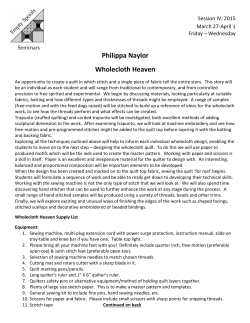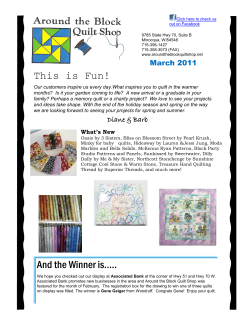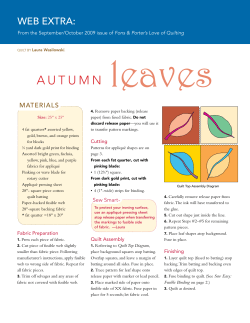
Pattern Section
Pattern Section THE BEST OF AMERICAN QUILTING July/August 2013 Pattern Section For templates that fit on letter size paper: 1. Print desired pattern pages at 100% (no scaling) printer setting. For templates that extend onto more than one letter-size paper sheet: 1. Print desired pattern pages at 100% (no scaling) printer setting. 2. Arrange so that registration marks align on both template pieces. 3. Trim overlapping portion at aligned sets of registration marks, carefuly aligning edges of template shapes, and tape securely. Templates in this issue Tween Tumbler Lilac Splendor Sweet Heirlooms Miss Kyra Sunflowers in Shades Folk Blossoms Baja Sunset Quiltmaking Fundamentals page 2-3 4-5 6 7 8-10 11 12 13-14 For Continuous Bias instructions and video go to McCallsQuilting.com/articles/continuous_bias Copyright 2013 Creative Crafts Group All rights reserved. Reader has permission to copy contents of this section for personal use. 1 McCall’s Quilting July/August 2013 Tween Tumbler 1 of 2 Tween Tumbler Template A This box measures 2 inches by 1 inch. Use for accurate scale when printing 2 McCall’s Quilting July/August 2013 Tween Tumbler 2 of 2 mbler Tween Tu Template B This box measures 2 inches by 1 inch. Use for accurate scale when printing 3 McCall’s Quilting July/August 2013 LILAC SPLENDOR 1 of 2 Lilac Splendor Template B Cut 24 each Green diagonal plaid and green floral Lilac Splendor Template E Cut 24 Dark purple mottle Lilac Splendor Template F Lilac Splendor Template A (entire wreath) Cut 6 Green floral This box measures 2 inches by 1 inch. Use for accurate scale when printing 4 McCall’s Quilting July/August 2013 Cut 12 each Green diagonal plaid and green floral LILAC SPLENDOR 2 of 2 Lilac Splendor Template C Cut 12 each Purple floral and purple diagonal plaid Lilac Splendor Template D Cut 24 Yellow mottle McCall’s Quilting July/August 2013 align with plaid Lilac Splendor Template G Cut 14 Purple diagonal plaid 5 SWEET HEIRLOOMS s oom Sweet Heirlooms Template B Cut 24 irl He te A eet Sw mpla 4 2 Te M align with seam This box measures 2 inches by 1 inch. Use for accurate scale when printing 6 McCall’s Quilting July/August 2013 lid Cut reen so mg ediu MISS KYRA Miss Kyra Template E Cut 12 Orange dot Miss Kyra Template C Cut 12 Pink dot Miss Kyra Template D Cut 12 Yellow check Miss Kyra Miss Kyra Template F Cut 64 Dark green texture Cut 64 Medium green texture Cut 32 Light green texture mplate A Assorted prints Miss Kyra Template B Cut 5 Yellow Dot Miss Kyra Template A Cut 100 Assorted prints 7 McCall’s Quilting July/August 2013 Miss Kyra Template A Cut 100 Assorted prints SUNFLOWERS IN SHADES 1 of 3 Sunflowers in Shades Template P Cut 2 Black solid Sunflowers in Shades Template Q/Qr Cut 1 each Assorted bright/dark print Sunflowers in Shades This box measures 2 inches by 1 inch. Use for accurate scale when printing Template R/Rr Cut 1 each Assorted bright/dark print Black permanent marker Sunflowers in Shades Black permanent marker Template S Cut 2 Gold/yellow texture Sunflowers in Shades Black permanent marker Template C (entire flower) Cut 13 Gold/yellow texture Sunflowers in Shades Template E Cut 2 Green texture Black permanent marker Sunflowers in Shades Template D Cut 13 Assorted bright/dark prints Sunflowers in Shades Sunflowers in Shades Template B Cut 6 each Green mottle and green texture 8 McCall’s Quilting July/August 2013 Template A Cut 6 Green texture Cut 7 Green mottle SUNFLOWERS IN SHADES 2 of 3 Black permanent marker Sunflowers in Shades Template G Cut 2 Black solid Sunflowers in Shades Template F Cut 2 Assorted bright/dark print Sunflowers in Shades Template H/Hr Cut 1 each Gold/yellow texture Sunflowers in Shades Template I Cut 2 Assorted bright/dark print Black permanent marker Sunflowers in Shades Template J/Jr Cut 1 each Assorted bright/dark print Black permanent marker Black permanent marker Sunflowers in Shades Template K Cut 2 Assorted bright/dark print Sunflowers in Shades Template L Cut 2 Black solid Black permanent marker Sunflowers in Shades Template M Cut 1 Green texture Sunflowers in Shades Template O/Or Cut 1 each Assorted bright/dark print Sunflowers in Shades Template N Cut 1 Assorted bright/dark print 9 McCall’s Quilting July/August 2013 Black permanent marker This box measures 2 inches by 1 inch. Use for accurate scale when printing SUNFLOWERS IN SHADES place on fold 3 of 3 Sunflowers in Shades ½ Template T cut out 10 McCall’s Quilting July/August 2013 This box measures 2 inches by 1 inch. Use for accurate scale when printing Folk Blossoms Folk Blossoms Template A Cut 18 each Red small floral, green/gold print, blue floral, and gold/red print Folk Blossoms Template B Cut 9 Cream/multicolor small floral 11 McCall’s Quilting July/August 2013 Folk Blossoms Template C Cut 16 Green texture BAJA SUNSET Baja Sunset 6 4¾˝ 4 9 3½˝ 4¾˝ 2 3½˝ 8 4¾˝ Foundation Master 12 McCall’s Quilting July/August 2013 1 3¾˝ 3 3½˝ 5 7 3½˝ 4¾˝ Make 49 copies Quiltmaking Fundamentals These instructions are intended to give you a brief and basic introduction to quiltmaking. Instructions for quilts in this issue are written for the individual with some sewing ex perience. Take time to review these pages before beginning if you are making your first quilt. Basic Quiltmaking Supplies Iron and ironing board Pencils and sharpener Quilting hoop or frame Quilting thread (cotton for hand quilting, monofilament or cotton for machine quilting) Pins and pincushion Rotary cutter and mat (at least 18˝ x 24˝) Rulers: 2˝ x 18˝, clear plastic 12˝ square, and 6˝ x 24˝ for use with a rotary cutter Sewing machine Sewing thread in colors to match your fabrics Shears, 8˝ (for fabric) Fabric Preparation We recommend washing, drying, and pressing all fabrics before using. Pre-washing will help wash out excess dye and preshrink the fabric. Occasionally, a fabric will continue to “bleed” after several washings. If this occurs, add one cup of white vinegar to one gallon water and soak fabric to help set the color. If the fabric still continues to “bleed,” do not use the fabric. To add body to prewashed fabric, use spray fabric finish (not starch) when pressing. Pressing One of the most important steps in quiltmaking (and most sewing) is proper pressing. It is important to press after sewing each seam. When working with strips, be careful to press them straight and not make arcs. When working with bias edges, press them as little as possible before they are sewn to another piece. Use a light touch when pressing. Lift the iron, then place back down on the seam or piece to be pressed instead of “ironing” without lifting the iron. Be as careful pressing as you are cutting and sewing for the best possible results. Machine Piecing To join pieces by machine, place two pieces with right sides together. Align raw edges and insert pins, perpendicular to seam line, to secure. (Pins are removed just before reaching the sewing machine needle.) 13 McCall’s Quilting July/August 2013 When machine piecing, an accurate ¼˝ seam allowance is important. Place a piece of masking tape on your machine ¼˝ to right of your needle to mark a ¼˝ seam allowance. When stitching, align raw eges of fabric with tape. A ¼˝ presser foot is also available for most machines. A machine-stitched seam line is sewn from raw edge to raw edge, and backstitching is not necessary because seams will be crossed by another line of stitching. Seam allowances are normally pressed to one side, usually toward the darker fabric. Chain-Piecing To chain-piece, feed pairs of fabric pieces to be stitched under the presser foot one after the other, without cutting the sewing threads between them. After stitching the first pair, take a few stitches without any fabric under the needle; then insert the second pair. The sewing threads form short “chains” between the paired pieces. Con tinue in this manner until all pairs have been stitched. Cut the chains after stitching. Making Quick Triangles For two half-square triangles, place two squares right sides together. Draw a diagonal line across top square and stitch a ¼˝ seam on both sides of the line. Cut apart on the drawn line. This is particularly useful when working on scrap quilts. Machine Appliqué For the machine-appliqué method discussed below, all pattern pieces are cut without seam allowances. Then raw edges are covered with a close machine satin stitch or blanket stitch. Use a lightweight paper-backed fusible web to fuse the appliqué piece to the background fabric. Draw templates on the paper side of the fusible web. Fuse to wrong side of appliqué fabric. Peel paper off, and following manufacturer’s instructions, fuse appliqué to background fabric. Use com mercially made stabilizer or other material that will tear out of the stitching beneath the appliqué piece and background to add strength and firmness before machineappliquéing (stitching). Marking Quilting Patterns Always press the quilt top thoroughly before marking. Check for misalignment of seams or any puckering and correct, if possible. There are many marking tools available to quilters, including #2 pencil, water-erasable markers, chalk pencils, artist’s white or silver pencils, and many more. Before choosing the tool to mark the quilt top, ALWAYS TEST FOR REMOVABILITY. What works on one quilt may not work on the next! Quilts can be marked using stencils, templates, or rulers, to name just a few choices. As you progress, you will find the method that gives you the most satisfactory results. Commercially made stencils are available through quilt and fabric stores, or you can make your own from template plastic. Place the stencil on the quilt top, and lightly mark on the top, using the tool of your choice (for dark fabrics, dressmaker’s chalk pencil or a white or silver artist’s pencil work well). Backing The backing of a quilt is just as important as the quilt top. The fabric used should be of the same quality as the fabric used in the top. If making a wall hanging 32˝ wide or less, a seamless backing is easy to cut. For quilts larger than 32˝ wide, a seamed backing is necessary unless you are using fabric widths greater than the commonly used 40/42˝. Backing should be cut 4˝ larger than the quilt on all sides and sewn with a vertical or horizontal seam (choose seaming method that uses least fabric to make the backing size needed). Press backing seams open. Choosing Batting There are several factors to consider when choosing batting for a quilting project. How do you want the quilt to look? How close together will the rows of quilting be? Are you quilting by hand or machine? What is the end use of the quilt? All of these questions will affect which batting you choose for the project. Most batting comes in standard pre-cut sizes. The standard batting sizes are: Crib 45˝ x 60˝ Twin72˝ x 90˝ Full 81˝ x 96˝ Queen90˝ x 108˝ King120˝ x 120˝ Batting also comes in a number of differ ent fibers (not all fibers come in all standard sizes). If you prefer an old-fashioned looking quilt, looking a little rumpled and well loved, consider using batting that is mostly cotton (cotton batting requires more quilting than some other fibers). If you like “puffy” quilts, use a high-loft polyester batting. If you don’t want to do a lot of quilting, use a regular or low loft polyester. Batting also comes in wool and silk fibers (these are not as widely available as cotton and polyester batting). If you are not sure which batting is right for your project, consult the professionals at your local quilt or fabric store. Layering For any size quilt, other than a small wall hanging, layering and basting is easier when done with a partner. Whether you choose to quilt by hand or machine, the layering process is the same. There are, however, different basting methods for hand or machine quilting. Finger-crease the backing in half lengthwise to find center, and lightly mark on wrong side at bottom and top edges. On a smooth, flat working surface a little larger than the quilt, place backing with right side down. Smooth out any wrinkles until the backing is flat (use masking tape to tape backing taut to work surface, if possible). Un fold batting and layer it on backing. Smooth out wrinkles carefully, to keep backing wrinkle free. Fold the quilt top in half lengthwise to find center, and lightly mark on wrong side at bottom and top edges. With right side up, place quilt top on top of the backing and batting, keeping all layers wrinkle free. Match center marks of quilt top and backing. Remove any loose threads. Use straight pins to keep layers from shifting while you baste. Basting The purpose of basting is to hold the three layers together to prevent shifting while quilting. Therefore, the quilt should be adequately basted. Telltale signs of poorly basted quilts are puckering and wrinkling of the backing. If hand quilting, baste, using a darning needle threaded with approximately 18˝ of sewing thread. Insert needle through all layers in center of quilt and baste layers together using a long running stitch. The first line of basting should be edge to edge, up the vertical center of the quilt. The second line of basting should be edge to edge across the horizontal center of the quilt. Continue to baste in a grid or starburst pattern until the layers are completely stabilized. If machine quilting, instead of using needle and thread to baste, use nickel-plated safety pins. Start in the center of the quilt. In a circular pattern, radiating out to all edges, place a safety pin about every 4˝ (about the 14 McCall’s Quilting July/August 2013 width of a hand). If possible, avoid pinning in areas where you know you will be quilting (if quilting in the ditch, avoid pinning on seam lines). This is not always possible, and there are times that safety pins will have to be removed when machine quilting. Machine Quilting Because of the improvement in homesewing machines, machine quilting has become easier to do, and with practice, just like hand quilting, great results can be achieved. Machine quilting can be done using straight-line stitching, free-motion stitching, or a combination of both. After the quilt is pin-basted, roll both long edges toward the center of the quilt with the quilt top facing up. Keep rolling until there is about a 12˝-wide area between rolls at the center of the quilt. Use bicycle clips (sold in quilt and fabric stores) to secure rolls. Fold one unrolled end over several times so that the quilt is compact and will fit on your lap while you stitch. Before quilting, it is best to map out a strategy. The object of this strategy is to find the longest uninterrupted stitching routes. Once these routes are determined, make a directional map of your design to guide you as you stitch. This will enable you to stitch the longest line without stopping. The less you have to stop and start, the better. The even-feed foot or walking foot is helpful for straight-line stitching. It assists the top fabric through the machine at the same rate as the feed dog moves the bottom fabric. Place unrolled section of quilt under presser foot and stitch. Work to the right. When the right side is completed, remove quilt, reroll quilted side, turn it, and stitch left side. Rest the quilt in your lap while stitching and support the stitched quilt on a table be hind your sewing machine after it is stitched. A darning foot is used for free-motion quilting, with the machine’s feed dogs lowered. The quilt is slowly moved with your fingertips from side to side under the darning foot (your hands act as the quilting “hoop”). The machine should be operated at a steady, medium speed to prevent uneven stitches. Meander quilting and stippling are two types of free-motion quilting. Finishing Quilts can be bound with binding cut on the bias or on the straight grain. A continuous strip of bias is recommended for quilts that will be used frequently, and those with scalloped edges or rounded corners. (See How To Make Continuous Bias at McCallsQuilting.com.) Straight-grain binding is usually cut in 2½˝wide strips and folded in half lengthwise be fore being attached. (A ¼˝ seam allowance is included in the width measurements.) The width may vary according to the thickness of your quilt and your personal preference. Attaching the Binding A carefully stitched binding is vital to a successful quilt. To begin, stitch layers of quilt together ¼˝ from the quilt edge. Trim excess batting and fabric. With right sides together and raw edges even, pin the binding to the quilt top. If using a continuous binding, fold beginning end over with wrong sides together and start stitching at the midpoint of your quilt. If using straight-grain binding, start stitching 6˝ from the end of the binding at the quilt corners. Backstitch at the beginning and end of stitching. Stitch through all layers and miter the corners of the binding strips. Fold the binding to the quilt back, and blindstitch in place. To make straightgrain binding with overlapped corners, stitch binding to opposite sides of quilt and trim even with top and bottom. Blindstitch to quilt back. Stitch binding to top and bottom, leaving 2˝ of extra binding at each end. Fold the raw end of binding in, then fold binding toward back of quilt. Blindstitch in place, stitching corners securely. To miter corners of your binding strip, stop stitching ¼˝ from first corner and backstitch. Remove the quilt from the machine and turn it 90º. Fold binding strip over itself to form a 45º fold. When done correctly, the edge of the unattached binding will align with the quilt’s raw edge. Begin stitching again at the corner and backstitch. Continue around the quilt in the same manner until binding ends meet. Signing Your Quilt Signing your quilt is the most important step in quiltmaking, next to making it. It is a documentation of who made the quilt and when. Your documentation should include the name of the quilt, the quiltmaker, city, state, date, and quilt pattern. Special thoughts or feelings about the quilt can also be included. The documentation can be typed on muslin or written with a fabricmarking pen. Instead of making a separate label, many quilters embroider their name and the date into the top of the quilt or on the back.
© Copyright 2025
